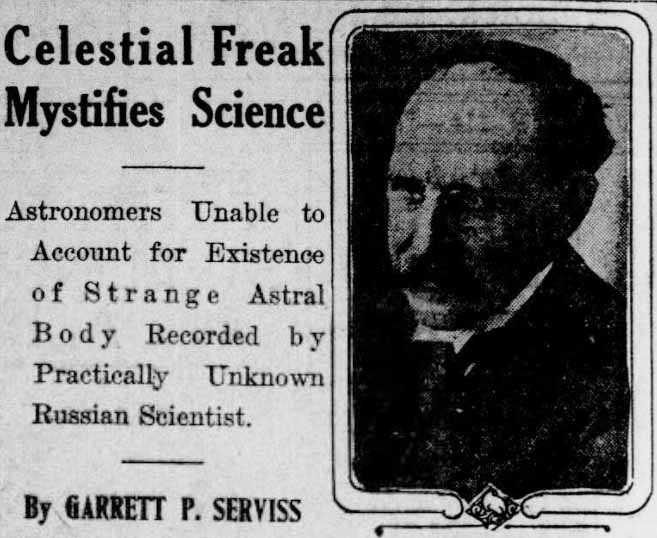
Published in 1913, Neujmin, a Russian astronomer credited with the discovery of a number of asteroids, spots something in space that cannot be labeled as an asteroid.
Celestial Freak Mystifies Science
There is a strange fish in the sky, a kind of astronomical “What-Is-It,” which made its first appearance to human eyes on September 6, when a young Russian astronomer, named Neujmin, in his remote observatory at Simeis, in the Crimea, found its image on a photographic plate that he had exposed to the sky three nights earlier.

Strange Body Didn’t Have the Appearance of a Comet
It did not look like a comet, and Neujmin thought that it must be a little planet, and as such he announced it to the astronomical world. The matter was turned over to certain astronomers who make a specialty of the study of the asteroids, or little planets, and they, after a careful examination, repudiated it. They declared that it could not be a planet, and must be a comet. They consequently declined to put it on their list.
But the mystery only deepened, for nobody could remember ever having seen such a comet as this. It looked like a star, but moved as no real star could do. For a few nights it appeared very slightly elongated, but then it lost this appearance and became round again. There was no tail – not even the root of a tail; the great Lick telescope failed to show the slightest trace of one.
Great difficulty was encountered in making out the path in which it traveled. According to some calculations it has been nearest to the sun as long ago as July 22, and was, at the moment of its discovery, fast gliding away again into space. According to others its nearest approach to the sun was a day or two after its discovery.

At the Lick observatory, where they do not call it either comet or planet, but give it the noncommittal and mysterious designation of the “Object Neujmin,” a period of revolution around the sun of nearly 17-1/2 years has been assigned to the stranger, but they add that, while there can not be any doubt about the elliptical nature of the orbit, the period of revolution may be shortened as the result of further observations.
In the meantime, the “Object Neujmin” has been provisionally accepted in the cometary sheepfold – to be turned out into the cold later, perhaps, if its claim can not be made good.
An “object” in the sky, about whose nature the astronomers themselves are in doubt – that is surely a new sensation! And yet we ought not to be very much surprised by it. The heavens are full of mysteries. Space is occupied by unknown, and ordinary invisible, bodies of many kinds.
The sun is carrying the earth continually into new regions, traveling northward at least 375,000,000 per year, and there is plenty of evidence that the contents of space, through which we are moving, vary to an astonishing degree.
In some places vast nebulae spread their glimmering wings and sprawling spirals over billions of miles. The earth caught in one of those celestial maelstroms would be less important than a chip in the rapids of Niagara. Some of the nebulae are invisible by direct vision, “dark nebulae,” Professor Barnard calls them, because their existence is only shown when they obscure hosts of stars behind them, like gigantic curtains of black gauze. These nebulous monsters may beset our course like the pitfalls, sins and snares of the Pilgrim’s Progress.
Elsewhere we see great stars, some of them far mightier than the sun, staggering under the burden of one or more huge, dark bodies, or swarms of smaller objects, which have attached themselves to them by the hooks of gravitation and can not be shaken off. If the sun should ever, like Sindbad, fall into the clutches of one of these “Old Men of the Sea” that lurk around the shores and shallows of the ocean of space, he could never free his neck from its clinging limbs. There is no wine that can inebriate gravitation and paralyze its grip.
Strange objects in the sola systems! If ever they begin to be seen in considerable numbers we shall have reason to fear that the sun is running us into danger in his headlong course. Every great dark body in space must have flocks of them about it. Every spinning nebula must be casting them off by millions.
Source: The San Francisco call. (San Francisco [Calif.]), 23 Oct. 1913.

